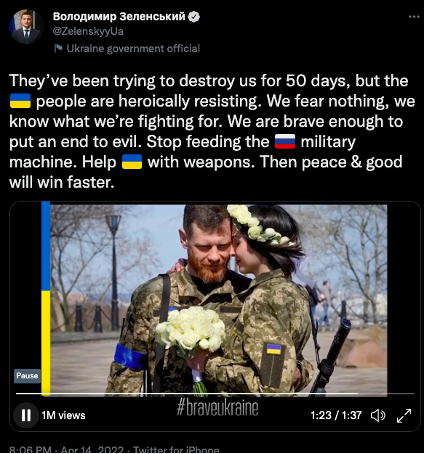
Social Media and Civilian Perspectives: The Use of Civilian Generated Digital Content in the Russo-Ukrainian War
By Maggie Fischer, MALD 2023 Candidate, The Fletcher School
Photo: Matteo Placucci/NurPhoto via AP
In early February 2022, the world watched as Russian tanks moved across the Ukrainian border. Almost overnight, videos and photographs of the invasion began to surface on virtually every social media platform, providing on-the-ground, real-time footage that captured global attention. While much of this content was republished by news media, it was and is a byproduct of the lived reality of war for the Ukrainian people.
Today, Ukrainians continue to post heartbreaking content online that captures evidence of human rights abuses and possible war crimes, making them a unique primary source through which to analyze the effect of this war on the civilian population. High digital literacy rates and strong digital infrastructure allow Ukrainians to use the internet to tell the story of this war at a pace that would be impossible in less digitized conflicts.
In my research, I sought to understand how this content is being used on social media and messaging platforms. I was able to identify three main uses by three distinct actors that are important to our understanding of the Russo-Ukrainian war. They also underscore how social media will continue to affect future highly digitized conflicts.
Digital Documentation in the Fight for Justice
The first use for this content is its potential to serve as evidence in the International Criminal Courts (ICC) investigation of Russian war crimes within Ukraine. The investigation was launched by the ICC on February 28, 2022, four days after the invasion began. The early launch of the investigation allowed the ICC to begin collecting evidence in lockstep with real-time developments in the conflict. However, the investigation faces many challenges. Investigators have been naturally slowed by restriction of access to Russian-controlled territories, security concerns for staff, and the destruction of evidence that occurs in conflict zones. While the ICC works with Ukrainian authorities and other partners, they cannot always be on the front lines or in the back alleys of all occupied Ukrainian cities. This is where the online content of human rights abuses posted by Ukrainians can play a major role in investigations. Ukrainian content showing human rights abuses contribute to a digital body of evidence that investigators can use to determine legal ramifications for the actions of Russian forces inside Ukraine, without having to be physically present at the site of the incident.
Digital Documentation as a Tool of Political Narrative
The second use for this content is at the national political level. Throughout the war, it is clear that Ukraine has depended on its Western allies for support and on its people’s will to fight. To maintain this support, the Ukrainian government has developed a sophisticated social media presence that uses footage of human rights abuses to encourage the Ukrainians to defend their country and engender support from Western allies. President Zelensky’s administration has leveraged the cheap, wide reach of social media to develop a narrative of Ukrainian unity. This narrative seeks to portray Ukraine as the underdog in the fight against Russia, supported by a people unified by their national identity. The government social media accounts use this content in two ways. Government accounts either repost publicly-posted footage of possible human rights violations with a government tagline, or state-created media uses this content to acknowledge the devastation of the war and magnify the narrative of an oppressed but defiant Ukraine.

The screenshots pictured above show how government actors use this content to project their own political narratives using social media.
Digital Documentation and Its Effect on Resilience
The third use I have identified is the way these posts are being used in the lives of the Ukrainian people. Ukrainians have had to cope with massive losses, and they must develop resilient responses to war trauma to survive. Resiliency is the human ability to survive and recover from major disturbances. It is important to support the development of resiliency through individual agency and a social network of support around the people experiencing trauma.
By posting online about the abuses that Ukrainians experience, they are writing the narrative of their trauma. When posting about a traumatic event online, people know they cannot control what has happened to them, but they can express agency over the way it is remembered. This technique allows others to support the traumatized person through comments, likes, and retweets. Using social media to build ties between people who are supporting each other through trauma allows physically destroyed networks to be rebuilt digitally. By posting content about human rights abuses, Ukrainians can develop their sense of agency regarding the trauma they have experienced and build networks to support each other online, hopefully resulting in higher community levels of resiliency.
Conclusion
As the globe becomes increasingly interconnected, the internet continues to change the way that the world processes war. The documentation of possible human rights abuses in Ukraine on social media and messaging platforms have allowed the world to experience the ongoing war in solidarity with the Ukrainian people. While my work represents early observations of how this content has been used within the conflict, further research is needed to follow these trends as the war continues. Furthermore, the impact that this content can have on war crime investigations and resilience development should be carefully studied; this can be used to inform practitioners on the use of social media and messaging platforms as tools for addressing the impact of war on civilian populations. But most importantly, this analysis has shown how social media’s ability to host content makes it a powerful tool for advocacy and national political strategy, while also highlighting the resiliency of the Ukrainian people.

